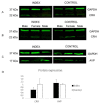Expression of Stress-Mediating Genes is Increased in Term Placentas of Women with Chronic Self-Perceived Anxiety and Depression
- PMID: 32752005
- PMCID: PMC7463995
- DOI: 10.3390/genes11080869
Expression of Stress-Mediating Genes is Increased in Term Placentas of Women with Chronic Self-Perceived Anxiety and Depression
Abstract
Anxiety, chronical stress, and depression during pregnancy are considered to affect the offspring, presumably through placental dysregulation. We have studied the term placentae of pregnancies clinically monitored with the Beck's Anxiety Inventory (BAI) and Edinburgh Postnatal Depression Scale (EPDS). A cutoff threshold for BAI/EPDS of 10 classed patients into an Index group (>10, n = 23) and a Control group (<10, n = 23). Cortisol concentrations in hair (HCC) were periodically monitored throughout pregnancy and delivery. Expression differences of main glucocorticoid pathway genes, i.e., corticotropin-releasing hormone (CRH), 11β-hydroxysteroid dehydrogenase (HSD11B2), glucocorticoid receptor (NR3C1), as well as other key stress biomarkers (Arginine Vasopressin, AVP and O-GlcNAc transferase, OGT) were explored in medial placentae using real-time qPCR and Western blotting. Moreover, gene expression changes were considered for their association with HCC, offspring, gender, and birthweight. A significant dysregulation of gene expression for CRH, AVP, and HSD11B2 genes was seen in the Index group, compared to controls, while OGT and NR3C1 expression remained similar between groups. Placental gene expression of the stress-modulating enzyme 11β-hydroxysteroid dehydrogenase (HSD11B2) was related to both hair cortisol levels (Rho = 0.54; p < 0.01) and the sex of the newborn in pregnancies perceived as stressful (Index, p < 0.05). Gene expression of CRH correlated with both AVP (Rho = 0.79; p < 0.001) and HSD11B2 (Rho = 0.45; p < 0.03), and also between AVP with both HSD11B2 (Rho = 0.6; p < 0.005) and NR3C1 (Rho = 0.56; p < 0.03) in the Control group but not in the Index group; suggesting a possible loss of interaction in the mechanisms of action of these genes under stress circumstances during pregnancy.
Keywords: RT-qPCR; antenatal stress; hair cortisol; human; term-placentae.
Conflict of interest statement
The authors declare no conflict of interest. The funders had no role in the design of the study; in the collection, analyses, or interpretation of data; in the writing of the manuscript, or in the decision to publish the results.
Figures




Similar articles
-
Maternal prenatal stress and placental gene expression of NR3C1 and HSD11B2: The effects of maternal ethnicity.Psychoneuroendocrinology. 2018 Jan;87:166-172. doi: 10.1016/j.psyneuen.2017.10.019. Epub 2017 Oct 26. Psychoneuroendocrinology. 2018. PMID: 29100173
-
Influence of labor on direct and indirect determinants of placental 11beta-hydroxysteroid dehydrogenase activity.Arch Gynecol Obstet. 2021 Feb;303(2):401-408. doi: 10.1007/s00404-020-05755-4. Epub 2020 Sep 3. Arch Gynecol Obstet. 2021. PMID: 32880710 Free PMC article.
-
The roles of DNA methylation of NR3C1 and 11β-HSD2 and exposure to maternal mood disorder in utero on newborn neurobehavior.Epigenetics. 2013 Dec;8(12):1321-9. doi: 10.4161/epi.26634. Epub 2013 Oct 17. Epigenetics. 2013. PMID: 24135662 Free PMC article.
-
Placental corticotrophin-releasing hormone, local effects and fetomaternal endocrinology.Stress. 2001 Dec;4(4):219-33. doi: 10.3109/10253890109014747. Stress. 2001. PMID: 22432143 Review.
-
Vasopressin and the regulation of hypothalamic-pituitary-adrenal axis function: implications for the pathophysiology of depression.Life Sci. 1998;62(22):1985-98. doi: 10.1016/s0024-3205(98)00027-7. Life Sci. 1998. PMID: 9627097 Review.
Cited by
-
Maternal Distress during Pregnancy and the Postpartum Period: Underlying Mechanisms and Child's Developmental Outcomes-A Narrative Review.Int J Mol Sci. 2022 Nov 11;23(22):13932. doi: 10.3390/ijms232213932. Int J Mol Sci. 2022. PMID: 36430406 Free PMC article. Review.
-
Multiomic analysis implicates nuclear hormone receptor signalling in clustering epilepsy.Transl Psychiatry. 2024 Jan 27;14(1):65. doi: 10.1038/s41398-024-02783-5. Transl Psychiatry. 2024. PMID: 38280856 Free PMC article. Review.
-
Prenatal stress, anxiety and depression alter transcripts, proteins and pathways associated with immune responses at the maternal-fetal interface†.Biol Reprod. 2022 Mar 19;106(3):449-462. doi: 10.1093/biolre/ioab232. Biol Reprod. 2022. PMID: 34935902 Free PMC article.
-
O-GlcNAc transferase in astrocytes modulates depression-related stress susceptibility through glutamatergic synaptic transmission.J Clin Invest. 2023 Apr 3;133(7):e160016. doi: 10.1172/JCI160016. J Clin Invest. 2023. PMID: 36757814 Free PMC article.
References
Publication types
MeSH terms
Substances
LinkOut - more resources
Full Text Sources
Medical
Miscellaneous

